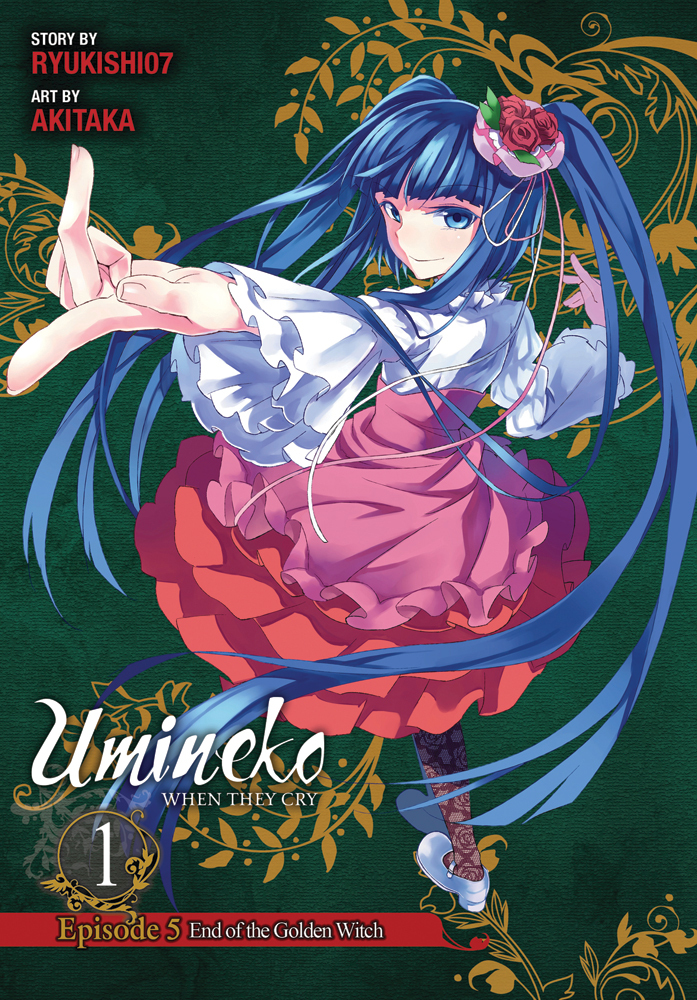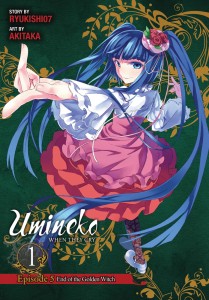Story by Ryukishi07; Art by Akitaka. Released in Japan in two separate volumes as “Umineko no Naku Koro ni: End of the Golden Witch” by Square Enix, serialized in the magazine Gangan Joker. Released in North America by Yen Press.
While Higurashi was divided into four Question Arcs and four Answer Arcs, Umineko plays it cagier, saying that the last four arcs are ‘Core Arcs’. Getting closer to the truth, but you’ll still have to dig for most of the answers. The first of these arcs, End of the Golden Witch, lives up to that name, as we skip most of the fluff and romance we’ve gotten in earlier arcs and go straight to what’s important: the Epitaph, the Gold, and the Murders. That said, there is one big difference: Lambdadelta and Bernkastel are in charge now, not Beatrice. And, as a result, everything is a bit twisted.
Ronove and Virgilia helpfully explain that our replacement game masters can’t do things impossible for Beatrice to do, but they can do things Beatrice WOULDN’T do. We see a bit of that in the scene with Natsuhi and Beatrice having tea together while reminiscing about her honeymoon with Krauss. It’s the sweetest scene in the whole volume, and has absolutely nothing whatsoever to do with solving the game or defeating Beatrice. Yet Bernkastel takes delight in telling us, in Red Truth, that Natsuhi is simply having tea by herself, the conversation never happened. Beatrice used the Red truth to stop Battler going down false paths, or lead him closer to where she wanted him to go. Bern uses the Red Truth to be mean because she finds it hilarious.
This leads me to the new character that enters the series at this point. That’s her on the cover, Erika Furudo. No, not Rika Furude. No, not Frederica Bernkastel. Ryukishi said in a recent interview that he regards Rika looking like Bern to be similar to Tezuka’s ‘star system’, where Rock or Lamp might show up in any work as a “different” but similar character. Fans of Rika were already a bit surprised that Bern turned out to be a heartless villain (though honestly, they can’t have been TOO surprised… go read Higurashi’s darker moments again). Erika, though, is written entirely to irritate, to annoy, and to make the reader hate her.
I was wondering how Yen Press would handle translation for the scene where Erika sums herself up best, and I am very pleased it’s 100% as fans of the game will remember: Erika, fantasizing about seeing Jessica in tears after the epitaph is solved, leers as she describes herself as an “intellectual rapist” who enjoys wreaking havoc for the sake of it. Which makes sense, given that she’s basically Bernkastel imposing herself on the island as a self-insert. Even when Erika tries to make nice and simply be a goofy, slightly off-kilter young girl, it looks calculated and wrong.
There is another new character we see here, of course, which is the mysterious “man from 19 years ago” who keeps calling Natsuhi on the phone and driving her into hysterics. Natsuhi is accused of the murders by Erika in a sort of flashforward at the start of the book, so we know she’s in for a terrible arc. And indeed, as we’ll see in the next omnibus in September, she is not without horrible crimes in her past. But honestly, Krauss, Natsuhi and Jessica are probably my favorite of the four families, if only as they all clearly love each other and they’re all so BAD at showing it. (Krauss’ foray into Moon Tourism also doesn’t help.) Taking Natsuhi, who has trouble communicating even the most basic feelings of love and affection, and putting her through this is vicious.
We end this volume with what appears to be the First Twilight, so let me briefly discuss the manga adaptation here: it’s excellent. As with all other adaptations, things have been removed and shuffled around, but more than any other this one takes care to include everything important and show how important it is (such as the maid and baby being “lured” off a cliff to their death by golden butterflies and witches). The faces are also nicely done, particularly when Erika, Lambda or Bern is going creepy and horrible on us. And the cliffhangers are well-timed, driving you forward to see what happens next. As far as I can tell, the artist hasn’t really done much other manga, which is a shame; they do a bang up job here.
Umineko is still a wonderfully tense and intricate read, if you can get past the fact that everyone in it is a horrible person. We’ll see how things go once Erika gets to play The Detective next time.

